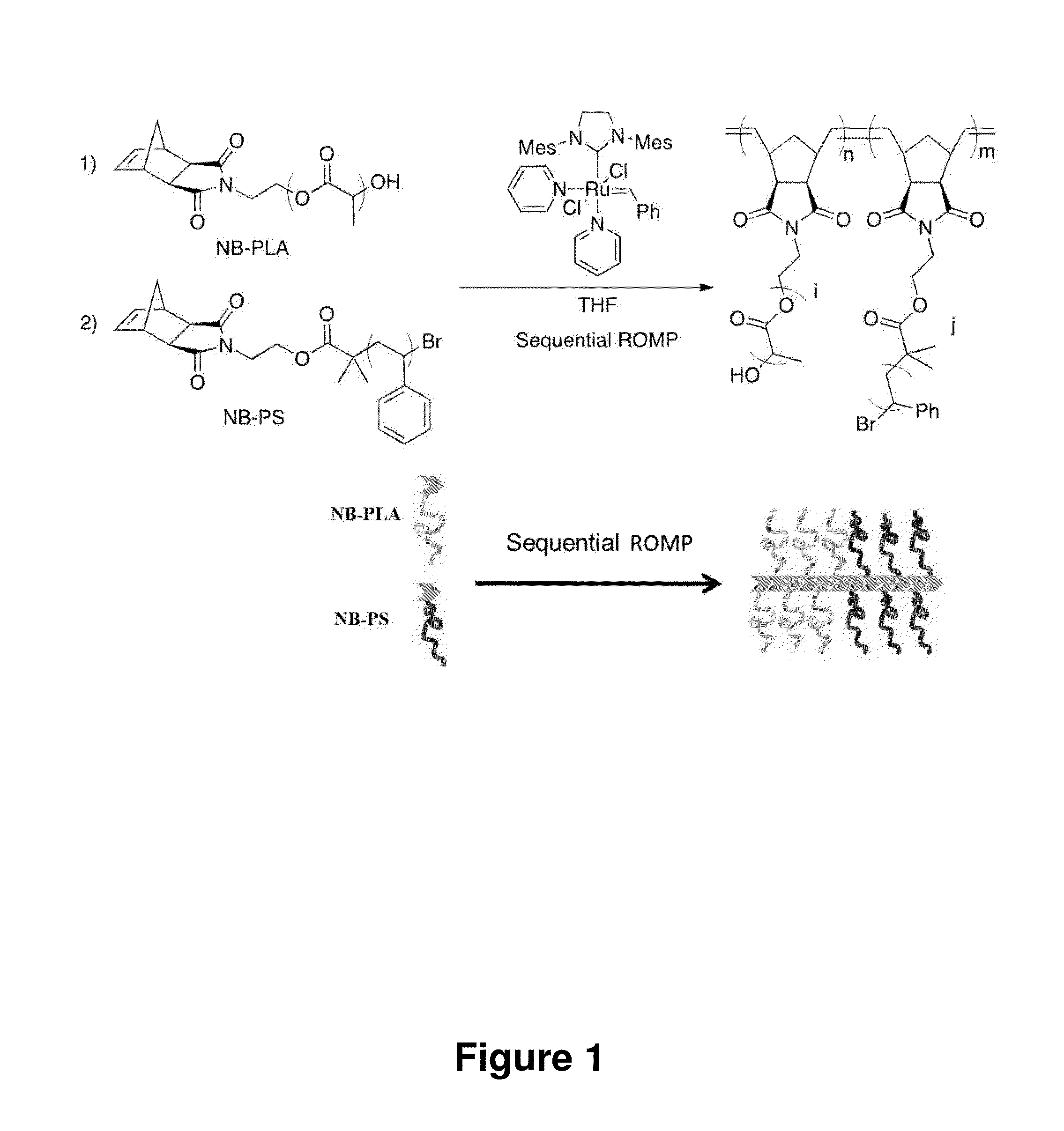Rapid self-assembly of block copolymers to photonic crystals
a technology of photonic crystals and copolymers, which is applied in the field of rapid self-assembly of block copolymers to photonic crystals, can solve the problems of ineffective annihilation of defects, degradation of polymer chains, and limitations in the efficiency of initiation and conversion of monomers, and achieve the effect of enhancing the molecular self-assembly process
- Summary
- Abstract
- Description
- Claims
- Application Information
AI Technical Summary
Benefits of technology
Problems solved by technology
Method used
Image
Examples
example 1
Results of Annealing Studies
[0216]Table 2 shows the sample codes and characteristics of brush block copolymers (BrBCPs) used in this study. w-norbornenyl macromonomers containing polystyrene (PS) and polylactide (PLA) were synthesized and used to prepare BrBCPs according to the previously reported procedure, which was mentioned above [6f]. Thin films of BrBCPs were prepared on either hard or flexible and transparent surfaces and, to effectively induce well-developed nanostructures, thin films of BrBCPs, were then solvent annealed with tetrahydrofuran (THF) and / or chlorobenzene (CBz). Scanning force microscopy (SFM), transmission electron microscopy (TEM), and grazing incidence small angle scattering (GI-SAXS) were used to quantitatively and qualitatively characterize and analyze thin films of brush block copolymers.
TABLE 2Sample codes and characteristics of brush block copolymers.MolecularWeight ofDegree ofSample Codesg-Sag-LAbPolymerizationc[g-S / C]:[g-LA / C]d[g-S5.1k]50-b-[g-LA4.4k]...
example 2
General Procedure for Norbornene-Polylactide Synthesis
[0220]In a typical experiment, the desired amount of 2 and 8 g of 3,6-dimethyl-1,4-dioxane-2,5-dione were added to a flame-dried Schlenk tube along with 2-3 drops of bis(2-ethylhexanoate)tin. This mixture was put under at least three vacuum-argon cycles and then allowed to stir at 130° C. for 2-3 hours. After cooling to room temperature the product was dissolved in dichloromethane, filtered through a small pad of celite to remove catalyst and precipitated into cold MeOH.
Example 3
General Procedure for ATRP of Polystyrene
[0221]In a typical experiment, 10 mL of styrene that had been passed through basic aluminum oxide were added to an oven-dried Schlenk tube fitted with a septum. Then, the styrene underwent three freeze-pump-thaw cycles and was subsequently frozen again. Next, the appropriate amount of CuBr (0.3 equiv to initiator) was added to the frozen styrene under argon. This mixture was put under three vacuum-argon cycles befo...
example 4
General Procedure for Block Copolymerization of Two Macromonomers via ROMP
[0222]In a typical experiment, 150 mg of macromonomers were added to separate oven-dried small vials. The desired amount of catalyst was added to the third oven-dried small vial. The vials were brought into a drybox and the macromonomers were dissolved in the desired amount of THF ([M]0=0.05-0.10 M) while the catalyst was dissolved in 1.00 mL of THF. The desired amount of catalyst solution was injected via a microsyringe to the solution of macromonomer that was estimated to polymerize faster. When the first block was estimated to have formed21 (REF) the solution of the second macromonomer was added to the reaction mixture. This solution was allowed to stir for an additional 1-2 hours. The reaction was moved out of the dry box, quenched with ethyl vinyl ether and isolated by precipitation into MeOH.
PUM
| Property | Measurement | Unit |
|---|---|---|
| molecular weight | aaaaa | aaaaa |
| molecular weight | aaaaa | aaaaa |
| molecular weight | aaaaa | aaaaa |
Abstract
Description
Claims
Application Information
 Login to View More
Login to View More - R&D
- Intellectual Property
- Life Sciences
- Materials
- Tech Scout
- Unparalleled Data Quality
- Higher Quality Content
- 60% Fewer Hallucinations
Browse by: Latest US Patents, China's latest patents, Technical Efficacy Thesaurus, Application Domain, Technology Topic, Popular Technical Reports.
© 2025 PatSnap. All rights reserved.Legal|Privacy policy|Modern Slavery Act Transparency Statement|Sitemap|About US| Contact US: help@patsnap.com



